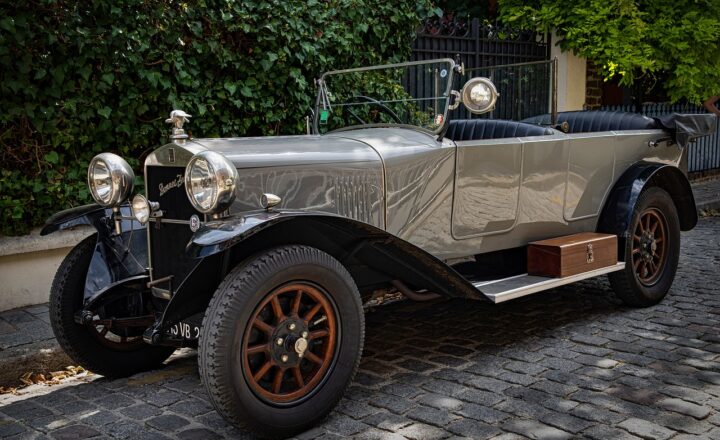The Chrysler PT Cruiser: The Controversial Retro Design That Gained a Cult Following
November 13, 2024

When the Chrysler PT Cruiser first hit the market in 2000, it sparked immediate conversation. Some hailed it as a bold departure from conventional design, while others dismissed it outright as a quirky misstep. Torn between admiration and criticism, the PT Cruiser became a defining model of the early 2000s, carving a niche that would eventually lead to a dedicated cult following.
1. The Birth of the PT Cruiser: A Unique Concept
The PT Cruiser was conceived by Chrysler as a compact car that offered the practicality of an SUV without the bulkiness typically associated with larger vehicles. Designed by Brian Nesbitt, the PT Cruiser was heavily influenced by vintage design cues, mirroring the aesthetics of the 1930s and 1940s. Its unique boxy shape, retro styling, and sweeping curves appealed to nostalgia, targeting a demographic that craved a sense of individuality in an era dominated by sameness in automotive design.
The name “PT” stands for “Personal Transportation,” emphasizing Chrysler’s intention of making a vehicle that combined style with functionality. The initial reception at the 1999 North American International Auto Show was enthusiastic, and Chrysler began ramping up production, believing it could tap into a rather untapped market segment.
2. Design Features That Stood Out
One of the standout features of the PT Cruiser was its distinctively styled exterior. The car’s retro-inspired front grille, high-mounted headlights, and sloped roofline made it instantly recognizable on the road. Chrysler’s choice of colors was equally compelling, offering consumers a palette that included vibrant hues like blue and yellow, as well as more traditional colors for the conservative buyer.
However, the interior design was just as exciting. With spacious seating, a modular interior layout, and ample cargo space, the PT Cruiser catered to the needs of families and young adults alike. Many owners appreciated the removable rear seats, which allowed for increased storage capacity—an unusual feature for a compact car. In some trims, leather seating, a sunroof, and upgraded audio systems added a level of luxury not typically associated with this car segment.
3. The Mixed Reception and Controversy
Despite its unique design and versatility, not everyone was enamored with the PT Cruiser. Critics often labeled it as “ugly” and “over-the-top,” pointing to its unconventional contours as a design flaw rather than a strength. Some auto reviewers at the time described it as a car where form overrode function, focusing on the design rather than performance aspects.
Initial sales were promising, but as time progressed, the novelty began to wear off. Sales figures fell short of Chrysler’s ambitious projections, leading the company to rethink its marketing strategy. The polarizing opinions on the PT Cruiser led to stronger divisions: some saw it as a rising star, while others considered it a fading curiosity.
4. The Cult Following Emerges
As the years passed, the PT Cruiser found its place among enthusiasts. Various online forums and social media groups saw the rise of PT Cruiser communities where owners could celebrate their cars’ unique attributes. Customization became a significant aspect of ownership; many drivers personalized their PT Cruisers with modifications ranging from lowered suspensions and flashy wheels to custom paint jobs and interior enhancements.
Events such as PT Cruiser car shows and meetups attracted passionate owners showcasing their prized vehicles, further solidifying the PT Cruiser’s status within the automotive hobbyist community. The automotive media began to recognize these communities, leading to features on dedicated PT Cruiser clubs and restoration projects.
5. The End of Production and Legacy
In 2010, Chrysler announced that production of the PT Cruiser would cease. While this announcement marked the end of an era, it also signified a new chapter for the retro-styled car. The PT Cruiser transitioned from being simply a car to becoming a cherished icon of early 21st-century automotive history. Owners and enthusiasts rallied around this shift, pushing for the preservation of the PT Cruiser as a classic car that embodied a distinct moment in automotive design.
The PT Cruiser’s legacy can still be seen in various forums discussing its unique design philosophy and its ability to evoke emotions and memories beyond just being a mode of transportation. It is often remembered for how it challenged conventional designs and sparked discussions about the direction of automotive aesthetics.
6. Conclusion: A Car Like No Other
The Chrysler PT Cruiser remains a deeply polarizing yet iconic figure in the automotive world. Its retro design may have drawn criticisms and led to questions about its market viability, but it also resulted in a cult following that continues to celebrate this unique vehicle. Whether you view it as a quirky misstep or a groundbreaking departure from design norms, there’s no denying the impact the PT Cruiser had on automotive culture.
For those who own or remember the PT Cruiser, it serves as a nostalgic reminder of a time when car design dared to be different. The PT Cruiser is more than just a car; it’s a testament to the idea that unconventional designs can resonate deeply, creating communities and conversations long after the production line has stopped.






